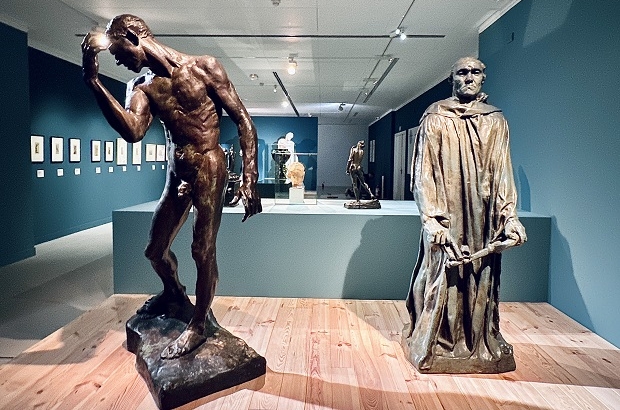- Daily & Weekly newsletters
- Buy & download The Bulletin
- Comment on our articles
Rodin. A modern Renaissance: Mons stages major exhibition of sculpture, drawings and paintings
For the inauguration of Mons’ new cultural pole (CAP), the city is staging a major exhibition dedicated to the father of sculpture, Auguste Rodin.
Gathering almost 200 masterpieces and rarely seen sculptures and drawings, Rodin. A modern Renaissance heralds a new chapter for the re-opened Fine Arts Museum, formerly known as BAM.
The chronological exhibition features pertinent dialogues with the renowned Belgian contemporary artist Berlinde De Bruyckere as well as prominent local Renaissance sculptor Jacques Du Broeuck.
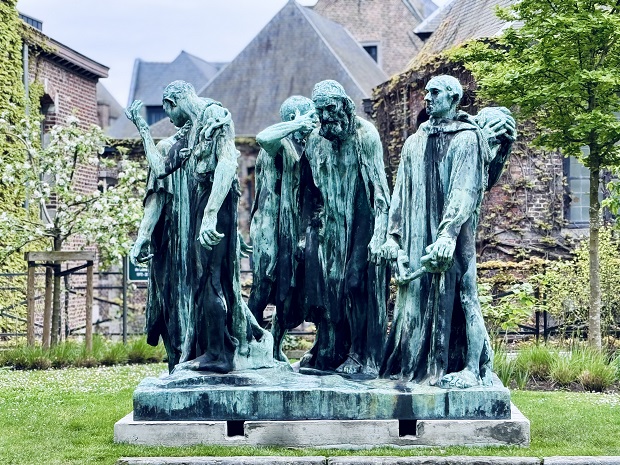
Running until 18 August, it incorporates works on public display in the Sainte-Waltrude Collegiate Church and the nearby city hall Mayeur garden, which is graced by Rodin’s most famous sculpture and a masterwork of tragedy, The Burghers of Calais.
It was an auspicious decision to dedicate the opening show to Rodin, involving significant loans from private and public collections, including The Louvre, Quai d’Orsay and Rodin Museum in Paris and the Victoria and Albert Museum in London.
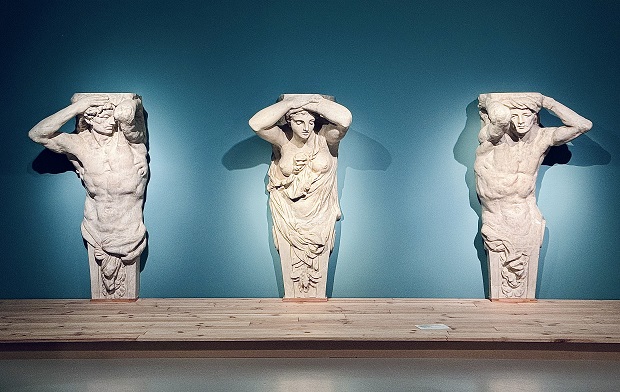
The artist spent six formative years in Belgium, from 1871 to 1877, where he transitioned from craftsman to artist; his eloquent style influenced by the country’s Flemish masters as well as Renaissance artists.
The unifying thread in this exhibition is Rodin’s treatment of the body, exemplified in his drawings and gouaches, a lesser-known aspect of his prolific career. They are a revelation, especially when shown alongside De Bruyckere’s similar visionary approach to rendering the body in non-three dimensional form.
In both drawing and sculpture, Rodin’s innovative representation of the body in all its physicality was exemplified by his conviction that art should be true to nature. He rebelled against the classical conventions of sculpture, in favour of a modern approach to nudes that meticulously demonstrated muscle, sinew and energy.
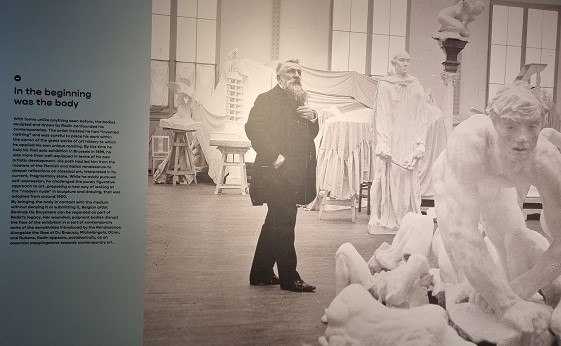
Rodin’s journey
At a school in Paris that prepared students for careers in craftmanship, Rodin learnt to draw from memory. It was a valuable lesson for the budding artist who successively failed entrance exams for art school. He claimed this frustration helped propel his drive and creativity, explains co-curator Christina Buley-Uribe.
It was as an assistant that Rodin was invited by a Parisian sculptor to travel to the Belgian capital. He was happy to leave his home city in 1871, then under siege by Prussian forces. Together, they worked on decorative elements for the Brussels’ bourse – fragments of the frieze are on display – with Rodin perfecting virtuoso skills at creating figures such as cherubs. He was soon signing works with his own name, and from his Ixelles studio, producing his own work. Travels to Italy and to cities in Flanders proved highly influential: Rodin was in total admiration of the paintings of Rubens.
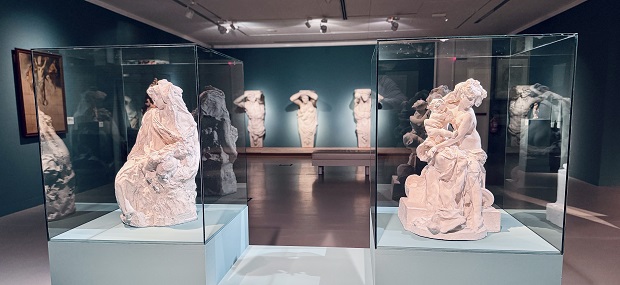
Two works are shown in tandem to underline how Rodin diverged from his contemporaries in his creativity. In Médée (above left), the burgeoning artist adopted a rough-hewn style; in flagrant contrast is the classical Jeune femme et enfant (right).
It was during his time in Belgium that Rodin received his first commission, which further enabled him to pursue his personal style. Notable were the marble sculpture Man with the Broken Nose and the elegant male nude The Age of Bronze that was his first life-size work.

With renewed confidence, Rodin returned to Paris where he exhibited the figurative and Florentine styled Saint John the Baptist, which was purchased by a Belgian collector. He also started the large-scale project that was to dominate his career: the bronze sculptural group work The Gates of Hell, inspired by Dante’s The Divine Comedy. It included one of his iconic pieces, The Thinker (pictured); the timeless nude is represented by a cast from Belgium’s Museum of Fine-Arts.
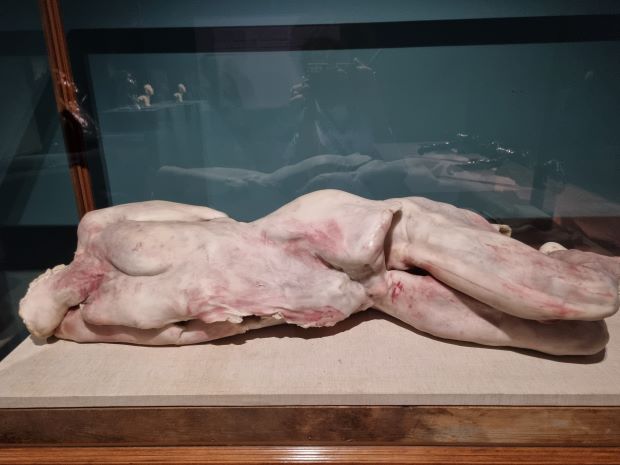
Another important piece created for the monumental inferno scene was The Martyr, a disturbing figure of a woman lying on her back, seemingly the subject of violence, yet showing no physical signs of abuse. A similarly tortured body is Constantin Meunier’s Martyr, albeit less ambiguous with raised arms adopting a position of crucifixion. As a counterpoint, one of De Bruyckere’s solitary wax figures from her ‘suffering body’ series (above) lies on its side, headless and vulnerable in a physical representation of the fragility of life.
More sensitive and intimate portrayals are on display in the triple presentation of Mask of Camille Claudel, Assembly of Two Hands, Amour and Psyché. Rodin’s sculptures provoked curiosity and criticism for their life-like portrayal. Contrary to sculptures of this time, he gave them a universal dimension, says Buley-Uribe. “The titles and the references always come after; his first aim is the expression of the body.”
In a separate space, De Bruyckere’s Arcangelo is a vertical female figure standing on the tips of her toes, head and shoulders draped in an animal skin. Is she ascending or descending? This is just one of ambiguities surrounding the pathos of the series of ‘blanket women’. Deliberately placed close to the elevated figure, but not in distracting proximity, an enlarged photographic print of one of the figures of Rodin’s The Burghers of Calais was retouched by the artist to dress the figure in a linear pleated robe.

Visionary drawings
Among Rodin’s later drawings and watercolours were flayed and black sketches and paintings. The former, known as écorché, served as anatomical studies of the human form; a traditional technique continued by Rodin under the influence of Greek and Renaissance figures. His black drawings were inspired by Michelangelo and visits to the Louvre and the Vatican. They were beautiful romanticised renditions of tormented scenes intended as preparatory works for The Gates of Hell, employing a subdued palette of sepia, black, white and grey.
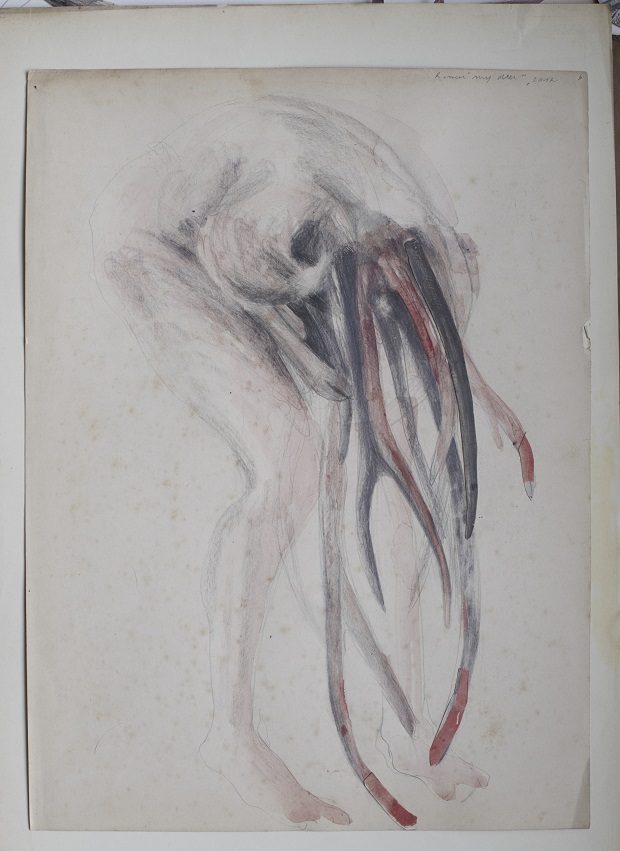
Revealing his precise draughtsman skills, these were spontaneous expressions. A large space in the exhibition focuses on his move to abstraction. Rodin pioneered an ‘instant drawing’ technique, involving the artist maintaining his gaze of the model without looking down at the paper. His use of decoupage and experimentation included presenting works on the diagonal or upside down to offer a different perspective. Largely exploring the feminine body, the series are presented alongside strikingly similar works by De Bruyckere; the two artists seamlessly blending together. The Ghent artist often draws inspiration from dancers from the city’s ballet company C de la B (pictured).
For both artists, works on paper represent an exercise in escaping the physical realities of making sculpture. United by a focus on the body, they achieve a lightness and exuberance in the artworks that then enriches their three dimensional medium. As Pierre Muylle, curator of the De Bruyckere section of the exhibition, points out, “If you are an artist in the 19th century or today, sculpture is a medium with very basic knowhow that also drives experimentation.”

Rodin’s work became more audacious as he pursued his search for artistic freedom. One of his many lessons from the medieval masters was that it wasn’t necessary to craft a complete body; a partial figure could be more powerful. He accumulated and repurposed fragments of body parts, increasingly showed the seams and other traces of the modelling casts. This figurative freedom imbued the work with an intense sense of vitality. A final section gathers major sculptures, including The Walking Man (pictured). It’s probably the finest example of Rodin’s ability to assembly different studies and work. His modern representation of antiquity epitomising his ability to convey movement.
“We wanted to show the bridge between the Renaissance and Rodin, who is seen as a very traditional 19th century artist, but in reality had a major influence on many artists in the early 20th century,” reiterates Buley-Uribe.
Rodin. A modern Renaissance
Until 18 August
CAP/ Fine Arts Museum of Mons
Rue Neuve 8
Mons
Photos: The Burghers of Calais ©BE CULTURE; Ornamental sculpture Boulevard Anspach ©BE CULTURE; ©Sarah Crew; Rodin The Thinker, Musées royaux des Beaux-Arts de Belgique; Berlinde De Bruyckere ©Sarah Crew; Feuille de croquis Études de putti et silhouette ailée collées sur un paysage de Belgique à la sanguine (verso), Dix études de personnages (recto) ©musée Rodin - photo Jean de Calan; Berlinde De Bruyckere, Romeu my deer ©Mirjam Devriendt; Rodin The Walking Man ©GrandPalaisRmn (musée d'Orsay)/Hervé Lewandowski












